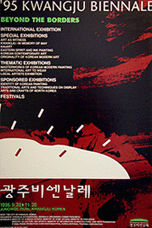1ST GWANGJU BIENNALE 1995
20 Sep - 20 Nov 1995
Beyond The Borders
20 September – 20 November 1995
Commissioners: Lim Young-bang, Clive Adams, Kathy Halbreich, Jean de Loisy, Anda Rottenburg, Oh Kwang-soo, Yoo Hong-jun
Sung-keum Ahn, Mario Airo, Osi Audu, Chant Avedissian , Guy Bar-Amotz, Jacques Bedel, Luis Fernando Benedit , Luchezar Boyadjiyev, Carlos Capelan, Maurizio Cattelan , Marek Chlanda and Elisabeth Brodin, Chuck Close, Milena Dopitova, Rosa El-Hassan, Fang Li-Jun , Nina Fisher and Maroan Elsani, Beatriz Gonzalez, Douglas Gordon, Kalicharan Gupta, Selma Gurbuz, Ken Hardy, Kay Hassan, Jose Antonio Hernandez-Diez, Kaoru Hirabayashi, Irene & Christine Hochenbuchler, Carsten Holler, Sung-dam Hong, Fabrice Hybert, Graciela Iturbide, Alfredo Jaar, Ravinder Jamwal, Michael Joo, Ikram Kabbaj, Nadim Karam, KCHO , Richard Killen, Kim Jung-heun , Kim Myung-Hye, Kim Yikyung , Joachim Koester, Guillermo Kuitca, Zofia Kulik, Toshihiro Kuno, Vladmir Kuprjianov, Guto Lakaz, Georges Lappas, Wen Lee, Yuri Leiderman, Lim Ok-sang , Geoffe Lowe, Lu Sheng-Zhong , Dalibor Martinis, Sancern Milindasuta, Tracey Moffatt, Oscar Munoz, Philip Napier, Mindaugas Navakas, Ernesto Neto, Juri Ojaver, Gabriel Orozco, Mabel Palacin, Steven Pippin, John Pule, Qiu Deshu, Khalil Rabah, Pedro Cabrita Reis, Franck Scurti, Shoichi Seino, Shin Kyung-ho , Penny Siopis, Jana Sterbak, Beat Streuli, Suh Jung-tae , Tan Chin-kuan , Pascale Marthine Tayou, test1, Diana Thater, Rirkrit Tiravanija, Olga Tobreluts, Toshihiro Kuno, Eulalia Valldosera, Patrick Van Caeckenbergh, MarijkeVan Warmerdam, Vedovamazzei Group , Xavier Veilhan, Jeff Wall, Heri Wardono, Carrie Mae Weems, Woo Jae-gil
Participating Countries : 92 Artists from 50 countries in the main exhibition and 249 in the special exhibition
Artist : 92
The first Gwangju Biennale featured 660 artists from 58 countries, exhibiting over 817 artworks. The theme “Beyond the Borders” conveyed a message of global citizenship that transcended divisions between ideologies, territories, religion, race, culture, humanity, and the arts. Aesthetically, it manifested itself in art’s ability to overcome meaningless pluralism and intended to establish new orders and relationships between the arts and mankind.
The exhibition was composed of six regionally focused sections: West Europe and East Europe / North America / South America / Asia / The Middle East and Africa / Korea and Oceania

